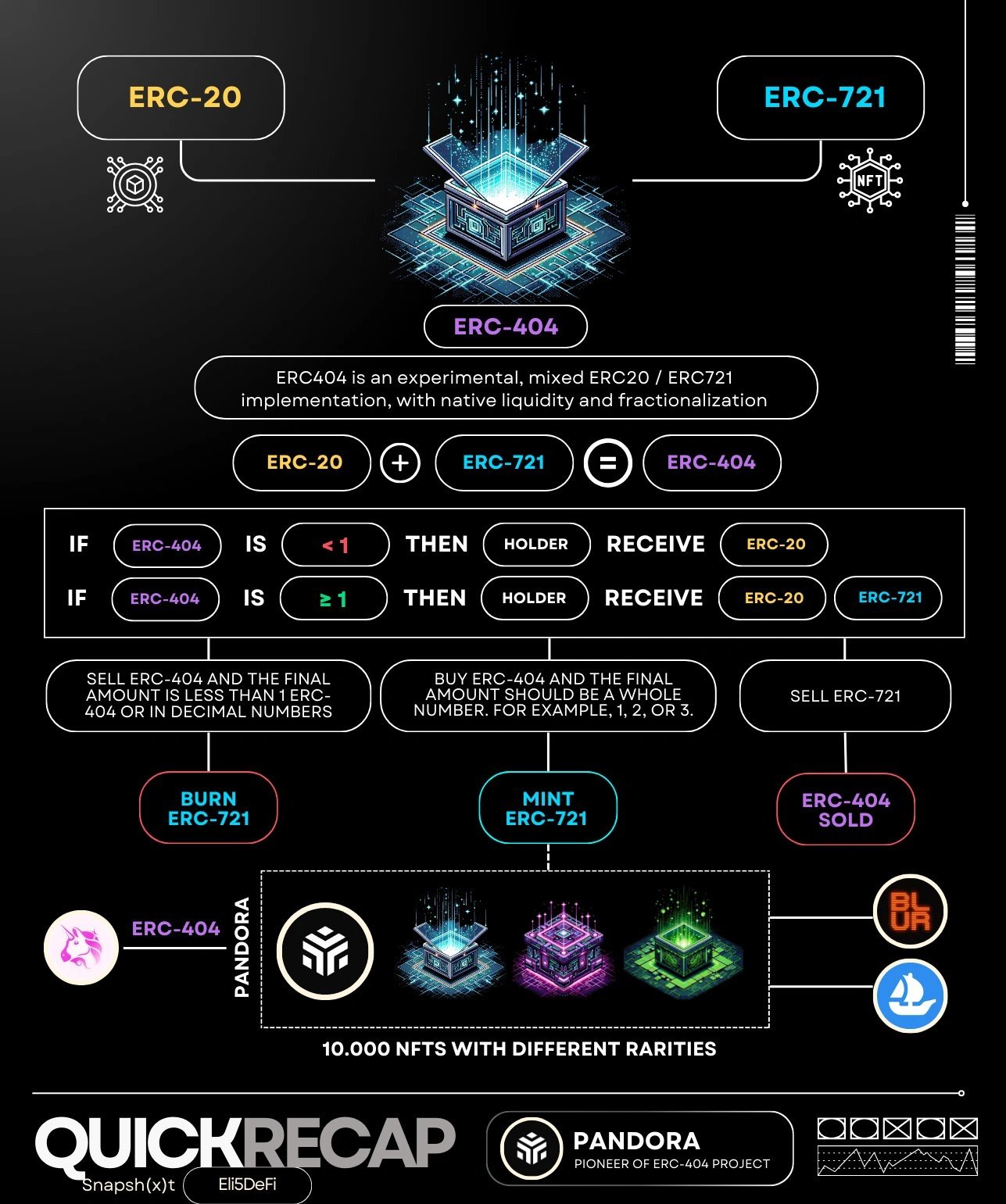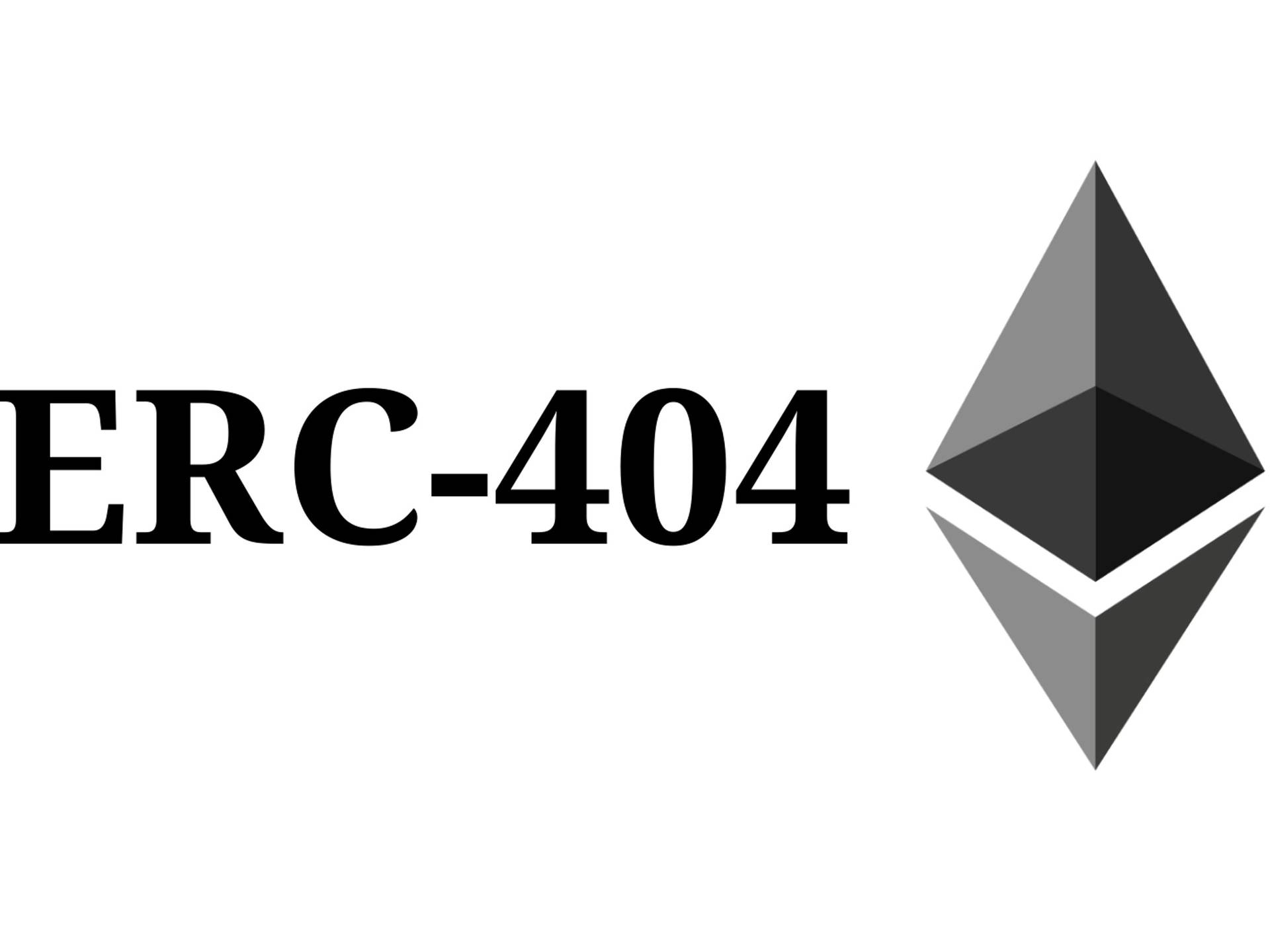ERC-404
ERC-404 is an experimental token standard built on the Ethereum blockchain. ERC-404 aims to combine the functionalities of ERC-20 tokens (fungible tokens) and ERC-721 tokens (non-fungible tokens, or NFTs) into a single standard.[4]
As of February 2024, ERC-404 is not an officially recognized Ethereum token standard. It is currently under development and has not yet been formally proposed as an official Ethereum Improvement Proposal (EIP). However, several projects have already adopted the standard, demonstrating its potential.[8][9][10]
Overview
An unofficial and experimental Ethereum standard dubbed ERC-404 is intended to become a hybrid of fungible and nonfungible tokens (NFTs). Created by pseudonymous developers known as “ctrl” and “Acme” under a project called Pandora, the standard mixes the tech behind ERC-20 fungible tokens with ERC-721 non-fungible tokens (NFTs).[3]

At the beginning of February 2024, there was a project called Emerald on Uniswap, that launched a set of improved token standards to solve the liquidity problem of NFT, directly building liquidity on Uniswap. Pandora was inspired by Emerald. Its three founders optimized the Emerald contract into the current ERC-404 token standard to solve the gap between the two traditional standards - ERC-20 and ERC-721. [6]
Pandora became the first ERC-404 token with a total supply of 10,000 launched on Feb. 2, 2024. Pandora has seen gains of over 1,850% in four days and a market cap of nearly $293 million while ERC-404 was not an official token standard. On February 6, 2024, Pandora transitioned to 2/4 multisig. [3][6]
When someone buys 1 Pandora token, they get the token plus a “replicant” NFT associated with that token. The NFT automatically gets minted to their wallet with randomized traits. If they end up liking their NFT, they can keep it. Or if they end up getting rare traits, they can sell via an NFT marketplace. If they don’t like/want the NFT, they can sell Pandora token. When they sell the token, the NFT associated with it gets burned.
NFTs are unique and indivisible and no one can own fractions of an NFT. ERC-404 circumvents this limitation by using token mint and burn mechanics to enable fractional transfers of an NFT. Issued tokens are linked to an NFT. If someone buys a full token, the linked NFT is minted to their wallet. If a fraction of the token is sold, the linked NFT is burned. If a wallet holding fractions of a token purchases enough fractions to hold a complete token, a new NFT is minted automatically.
ERC-404 aims to bind ERC-721 NFTs to the ERC-20 tokens, allowing for what some have described as fractionalized NFTs, allowing multiple wallets to each own a portion of a single NFT and use that portion to trade with or stake for loans.
While fractionalized NFTs do exist, they typically depend on an entity that locks up those NFTs in a wallet and issues tokens that represent that NFT. Those fractionalized tokens are freely traded and may not accurately match the locked NFT’s value. That’s one of the key problems ERC-404 sets out to solve. It allows multiple wallets to directly own a single NFT, and, in the future, create a use case where that specific exposure can be tokenized and used to take out loans or stake holdings.[2]
ctrl, one of the developers of Pandora and ERC-404 said:
“People in crypto hate friction. Every solution before ERC-404 had too much friction and was usually a wrapping solution that abstracted the original NFT that people wanted to fractionalize or make liquid,”
ERC-404 is not an officially recognized Ethereum token standard. The team is actively working on an Ethereum Improvement Proposal (EIP) for it.
If approved, the standard will be an “official” one recognized by the Ethereum Foundation, a nonprofit that maintains the Ethereum blockchain, for use within the Ethereum ecosystem as an agreed-upon framework that is compatible with Ethereum-based applications.[2]
Key features of ERC-404
- Fractional Ownership
ERC-404 introduces the revolutionary concept of fractional ownership, allowing investors to own fractions of non-fungible tokens (NFTs). This feature democratizes access to high-value digital assets, enabling broader participation in NFT markets. - Token Minting and Burning
The token minting and burning mechanics of ERC-404 are pivotal in facilitating fractional ownership. When a full token is purchased, representing complete ownership of an NFT, the corresponding NFT is minted to the buyer’s wallet. Conversely, when fractions of a token are sold, the linked NFT is burned, ensuring the integrity of ownership records. - Enhanced Liquidity and Trading
By enabling fractional ownership, ERC-404 enhances liquidity in NFT markets. Investors can trade fractions of NFTs without the need for complete ownership, thereby increasing market efficiency and reducing barriers to entry for smaller investors. This enhanced liquidity also fosters the development of new trading strategies and financial products centered around NFTs.
Platforms utilizing ERC-404
Here are some of the possible use cases.[1][5]
- Pandora
As one of the pioneering projects leveraging ERC-404, Pandora utilizes the standard to create NFTs with native fractionalization. This not only enhances liquidity but also enables innovative trading strategies, such as yield farming and liquidity mining, within the Pandora ecosystem. - DeFrogs
DeFrogs is a PFP (Profile Picture) collection that uses ERC-404. DeFrogs showcases the potential of ERC-404 in introducing deflationary NFT collections. By combining ERC-404 with unique economic models, DeFrogs creates scarcity and encourages value appreciation in its NFTs, attracting collectors and investors alike. - Monkees
The Monkees project explores the diverse applications of ERC-404, particularly in fractional ownership across various digital asset classes. By tokenizing assets such as artwork, real estate, and intellectual property, Monkees demonstrates the versatility of ERC-404 beyond traditional NFTs. - Gaming NFTs
ERC-404 revolutionizes the gaming industry by enabling the creation of gaming NFTs with randomized attributes and traits. These dynamic NFTs offer players unique gaming experiences and economic incentives, such as in-game rewards and asset interoperability across different gaming platforms.
